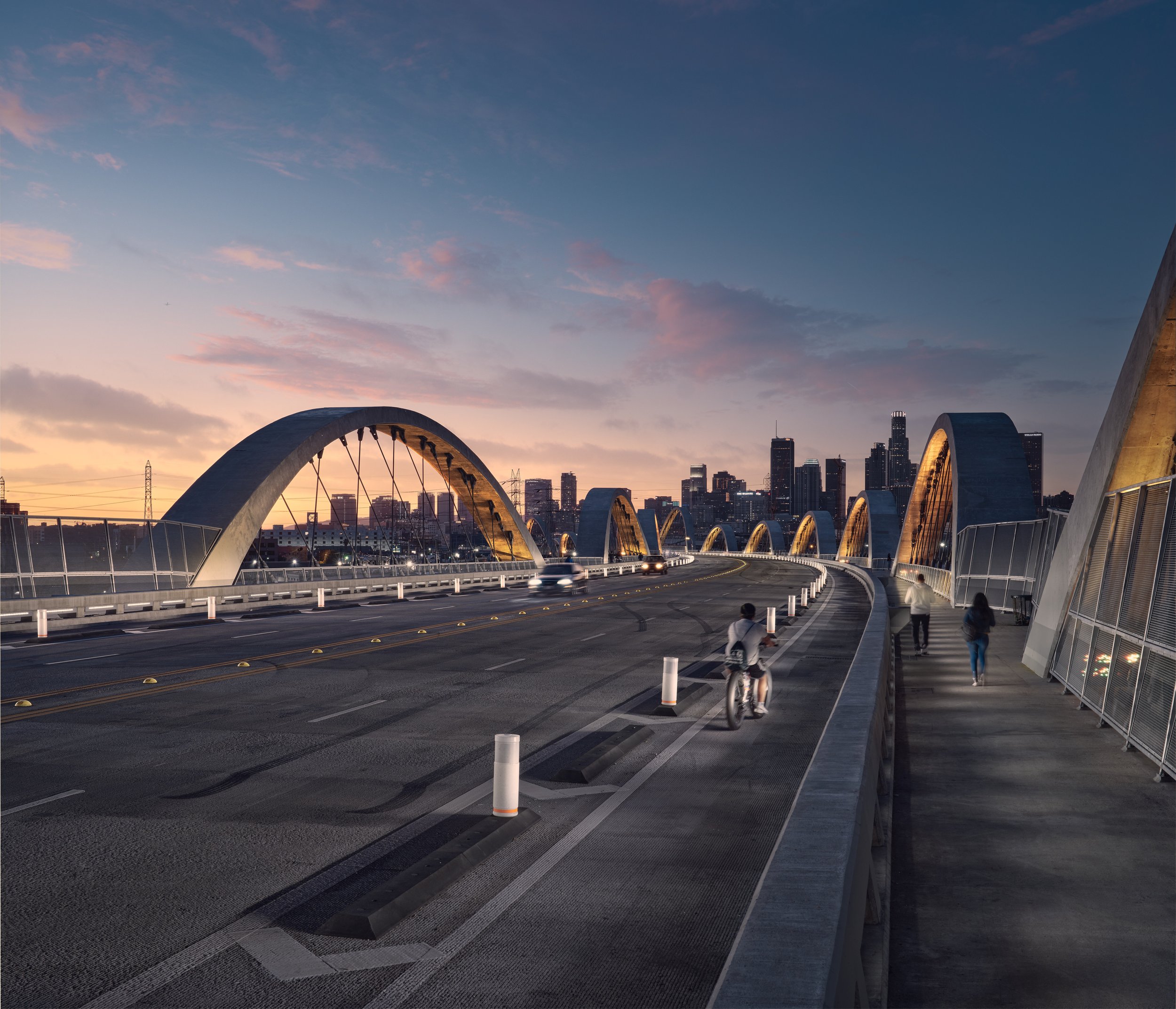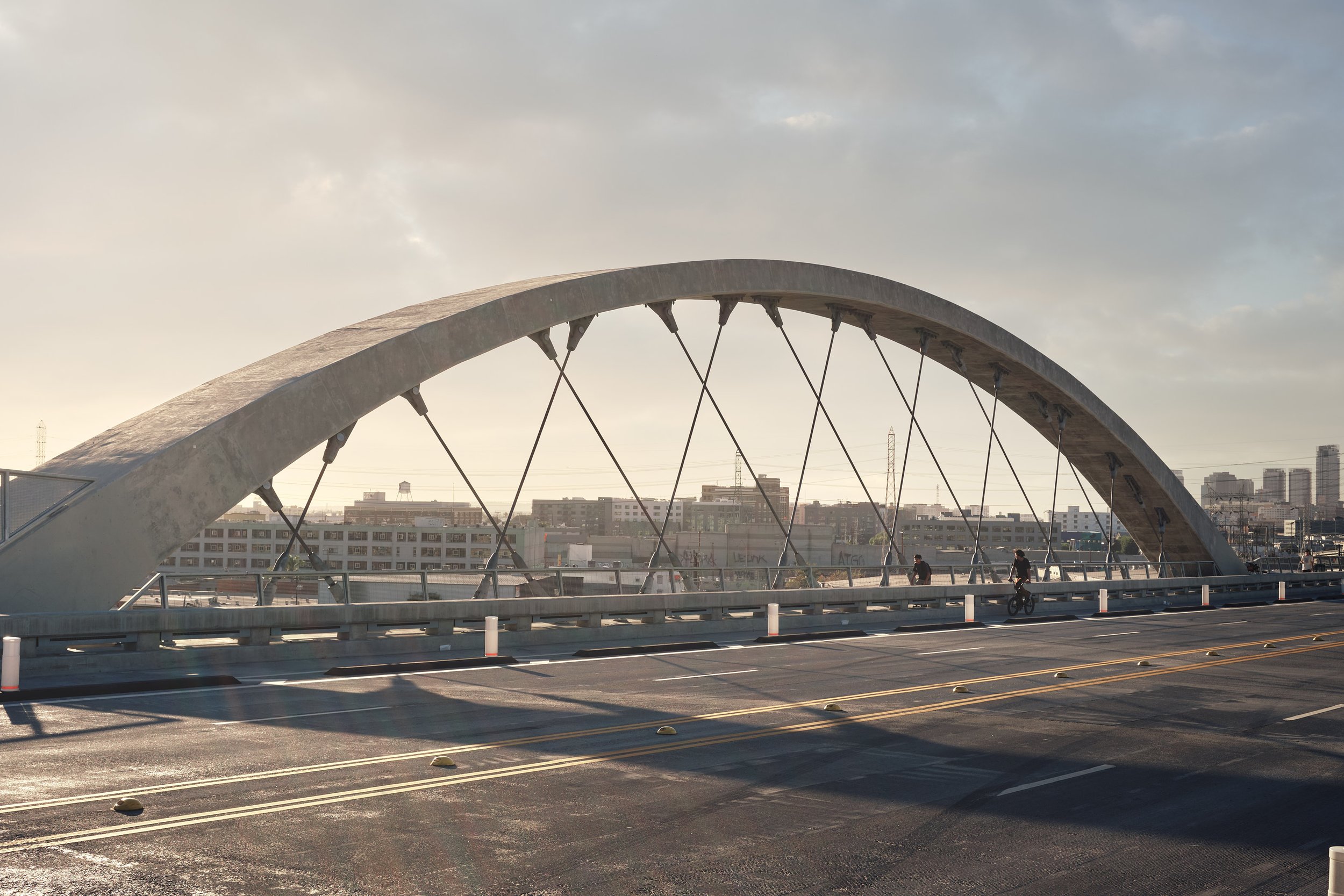Architectural Photography at the 6th Street Viaduct in Los Angeles
Architecture is for Humans
I love to see it in use, so that’s how I shoot it. My favorite thing to do in this world is wandering through cities and watch them breathe, so it stands to reason that my favorite projects are often public works designed to pump life into an urban landscape. They provide a function (parking garages, bridges, skateparks, etc.), but serve a higher purpose of cultural significance. You can usually associate them with their respective cities. These are the projects that inspire me to tell stories with images rather than just take pictures, and those are the stories that inspired me to become an architectural photographer in the first place.
The old 6th street viaduct was a historical landmark in Los Angeles that was easily spotted in hundreds of films, shows, and music videos since its construction in the 1930s. It drives traffic right into the heart of downtown’s Arts District. Unfortunately, it began to show its age. Structural issues required it to be completely replaced with world-class architect Michael Maltzan earning the commission. I had been eyeing it for months in anticipation of its completion and couldn’t wait to shoot it. It’s exactly what I look for in a personal project: mainly because it inspired my lazy butt enough to endure Los Angeles traffic to do it. Thankfully I had nothing better to do on Thanksgiving. It would prove to be the perfect day for a shoot.
From a design perspective, I really love that the bridge embraces the industrial, advantage-grade aesthetic around the Arts District and doesn’t try to deviate from it.
A Day to Night Transition
I knew I wanted a golden hour scene and a twilight scene that one could swipe through without changing the composition, so it did require me to be parked in a specific spot for a couple of hours. I knew once that tripod was planted, I wouldn’t be able to step away for anything else, ( it is LA, and you don’t want to leave your camera unattended), so I made sure to power through my “daytime” shot list beforehand.
Post Production was a matter of picking my favorite frames of human elements and cars and painting them where appropriate and just really measuring the lighting ratios I found favorable. Light and color change rapidly at this time of day/ twilight so plates had to be adjusted accordingly so they would match. Also, the lights on some of the arcs for the twilight shot weren’t on that day for some reason, so I had to add them in post. Hopefully, nobody gives it a second thought.
I spend a considerable amount of time perfecting my client work in post and was all too willing to adopt a different approach for this series. I cloned out some distracting trash and debris, but otherwise left the signs of use. When the bridge first opened, people would routinely gather and do illegal street races on it, hence all the skid marks on the concrete. Those scars tell a story and it just didn’t feel right to remove them.
A serendipitous moment when a family decided to take a break from their holiday bike ride to admire the view. Canon R5C + 70-200mm
These young Samaritans went out of their way to clean up garbage from the street. The kids are alright. Fuji X-pro 3 and 27mm Lens.
The Shoot
The logistical difficulty of shooting such large public spaces reveals itself in all the variables you can’t control There are many. This is an active street. I can’t just shut it down or yell at people to get out of my shot, and since it is downtown Los Angeles, it can be quite sketchy, so I had to account for my own personal safety while also concentrating on the work with over 10k worth of gear on me. ( I did this with no assistant or anyone to help me). Some of the compositions I got would have been impossible under normal circumstances as they required me to be on the street where the bridge is normally congested with cars.
I solved this by picking the perfect day to shoot it: Thanksgiving. I have no family in LA, so I had nothing better to do anyway, and by 2 pm most people were with theirs, which provided the rarest of events: Los Angeles without traffic. Something to truly be thankful for!
It was perfect. I had the whole bridge to myself and roamed around at will without consciousness. There was just enough human and car traffic to add elements of life to my frames without being overwhelmed with congestion. It also meant I could fly the drone with minimal risks as I didn’t have to worry about flying over people or traffic.
If I had shot this on a normal day, I probably would have been overwhelmed with activity all around me and likely wouldn’t have been able to focus as much of my energy as needed on the project itself, so timing really was everything. The most exciting thing to happen was being yelled at by a cop to get off the street at one point, but he drove off and the rest was uneventful.
Arches as far as the eye can see. The 70-200 mm lens allows me to compress objects further away making them bigger.
The bridge creates a harmonious ecosystem of all varieties of pedestrian traffic: Cyclists, Cars, and Humans on foot.
A bird’s eye of view of the bridge complete with its very own skid marks courtesy of the illegal street races that would occur when it first opened.
Another low key favorite image. the leading lines and rich contrast make it a feast for the eyes. I feel compelled to print it.
The second major challenge was simply getting through my shot list in time. Like I mentioned before, I had a very limited window of time lighting-wise to get all the shots I wanted, which were a combination of wide establishing shots, details/vignettes, and drone shots, so as much as I hate talking about gear under normal circumstances, there are times when it does matter.
My preparation for this shoot resembled a montage for an action film where we see a series of cuts of our hero arming himself to the teeth before a major showdown.
I had my Canon R5 with a 70-200 RF lens strapped across my chest for details and background compression. My fuji x-pro 3 occupied a second strap on my hip with a 27mm (40mm FF equivalent) lens. This would be my rapid-fire option to get more reactive shots as life unfolded before me. And finally my Fuji GFX 100s on a tripod and a trigger for my “hero shots.”
I threw everything else in a camping wagon, so I could switch lenses and fly the drone at a moment’s notice and moved as fast as I could between shots that were planned and opportunities that presented themselves at the moment. My work lately has greatly benefitted from incorporating more hand-held, fire-from-the-hip shots and letting them complement my more polished tripod shots. It’s made me a better storyteller with my photography and has added a new level of joy to the overall experience.
This establishing twilight aerial is one of my personal favorites with the illuminated bridge lighting the way and guiding the eye to the city in the distance. It demonstrates the bridge’s purpose in one simple image (connecting Boyle Heights to the Downtown Arts District), and it highlights the design elements. But it also possesses an ethereal magical quality that personally reminds me of the Bifrost bridge connecting Midgard to Asgard, which probably does nothing more than expose me for the huge nerd that I am. The color harmony just works for my eyes too as the surrounding warehouses are dim and cool while the bridge, the main subject, is the brightest thing in the image and just emanating with warmth.
Endless options for those seeking an interesting backdrop “for the gram.” Canon R5C + 70-200. Architectural photography always benefits from the inclusion of human elements to demonstrate a sense of scale by juxtaposing the relationship in size between people and the structure.
Why Personal Projects Matter
I could write several sermons on the importance of personal projects. They’re as important for your growth as exercise is for your health. We can get so caught up in feeding our bank accounts in this feast-or-famine industry that we often neglect to nourish our souls.
Personal projects give you the rope needed to experiment, try new techniques, dip into new aesthetic preferences and fail with confidence. And you get 100% creative control over the final product, which never happens on a client shoot unless you’re James Cameron or Martin Scorsese. This is important because these shots are often the most interesting work you’ll produce and what you’ll be known and hired for. So if you want to get hired for X, shoot more of X, even if it’s on your own time and dime.
A substantial amount of the client work I do is hidden under NDA or consists of a full copyright buyout. It can be quite some time before I can post it to my website and social media channels, if at all. That’s just how my career seems to be unfolding as my clients lately have mostly been major hospitality and retail brands vs architects and designers. So this stuff gets me noticed. Most of the content on my website consists of it, and it creates a plethora of opportunities for SEO optimization as you can create blog posts and youtube videos from it. It’s not uncommon for clients to hire me for personal work as they often tell me something along the lines of “we loved your shots of X & Y.”
I always say that if you’re good at something never do it for free, but personal is the type of “free work” I approve of since it’s an investment in yourself. And as an added bonus, you can still offer licenses to the various vendors involved in the project and possibly make a profit too.
This project couldn’t have come at a better time for me. It’s been a great year for business, but not without its humbling challenges. I’ve been slammed and overwhelmed since July and haven’t had the time to prioritize art for art’s sake.
Shooting commercial photography often means relinquishing control to “leadership” decisions that often don’t mesh with your aesthetic. That’s ok. “That’s what the money is for.” as Don Draper would say. But too much of that can leave you feeling like a technician taking orders rather than an artist.
I was on the verge of burnout. Pursuing this project resuscitated me and reminded me that photography is fun and something I absolutely love to do, which is easy to forget when it’s also your main source of income.
Such an immersive backdrop for inspiration. I could spend hours here at the end of the day.
The benefits of shooting on Thanksgiving day include not having to fear being flattened into a pancake by LA traffic. And having a much cleaner canvas to shoot on without the usual bumper to bumper traffic. Fuji GFX 100s + Canon 24mm Tilt - shift lens.
That golden hour light was crucial for those long shadows cast on the bridge via its arches. Special shoutout to that patented Los Angeles haze for giving these images a natural ethereal filter.














